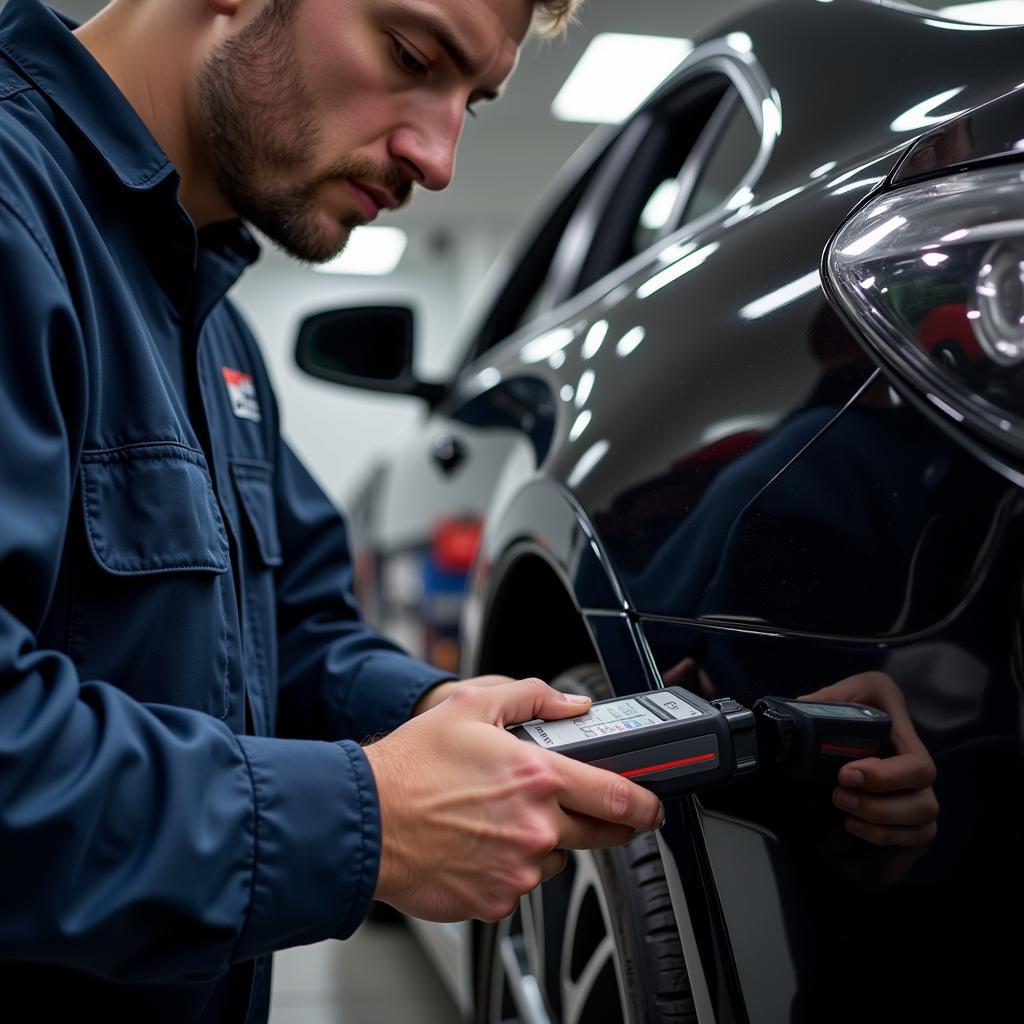The automotive industry has witnessed a technological revolution, with Car Mechanics Electronic Diagnostics emerging as a cornerstone of modern vehicle repair. Gone are the days of relying solely on mechanical expertise; today’s mechanics need a deep understanding of complex electronic systems to diagnose and repair vehicles effectively.
The Rise of Electronic Systems in Vehicles
Modern vehicles are equipped with an intricate network of electronic control units (ECUs) that manage everything from engine performance and emissions to safety features and in-car entertainment. These ECUs communicate with each other through a network known as the Controller Area Network (CAN), constantly exchanging data about the vehicle’s health and performance.
 Electronic Control Units in a Modern Vehicle
Electronic Control Units in a Modern Vehicle
The Importance of Car Mechanics Electronic Diagnostics
Car mechanics electronic diagnostics involve using specialized tools and software to interface with a vehicle’s ECUs, retrieve diagnostic trouble codes (DTCs), and analyze live data streams. This allows mechanics to:
- Accurately identify the root cause of faults: DTCs provide valuable clues about the nature and location of malfunctions within the vehicle’s electronic systems.
- Reduce diagnostic time: By pinpointing the source of the problem, mechanics can avoid unnecessary and time-consuming inspections.
- Improve repair efficiency: Access to live data enables mechanics to monitor the effectiveness of repairs in real-time.
 Mechanic Performing Car Electronic Diagnostics
Mechanic Performing Car Electronic Diagnostics
Essential Tools for Car Electronic Diagnostics
Effective car mechanics electronic diagnostics require a suite of specialized tools, including:
- Diagnostic Scanners: These handheld devices connect to the vehicle’s OBD-II port, allowing mechanics to read and clear DTCs, view live data, and perform various diagnostic tests.
- Multimeters: Essential for testing electrical circuits and components, multimeters measure voltage, current, and resistance.
- Oscilloscopes: These advanced tools provide a visual representation of electrical signals, allowing mechanics to diagnose complex sensor and actuator issues.
For a detailed look at various diagnostic car equipment, you can explore our dedicated page on diagnostic car equipment.
Common Applications of Electronic Diagnostics
Car mechanics electronic diagnostics play a crucial role in a wide range of automotive repair tasks, including:
- Engine Diagnostics: Identifying issues with fuel delivery, ignition timing, air/fuel ratio, and emissions control systems.
- Transmission Diagnostics: Diagnosing problems with automatic and manual transmissions, including shifting issues, clutch problems, and torque converter malfunctions.
- Brake System Diagnostics: Troubleshooting ABS, traction control, and electronic stability control systems.
- Airbag System Diagnostics: Identifying and addressing faults in airbag control modules, sensors, and deployment systems.
The Future of Car Mechanics Electronic Diagnostics
As vehicle technology continues to advance, the role of car mechanics electronic diagnostics will only become more critical. With the rise of electric vehicles (EVs), hybrid vehicles, and advanced driver-assistance systems (ADAS), mechanics need to stay abreast of the latest diagnostic techniques and equipment.
DiagFixPro provides valuable resources and insights into the ever-evolving world of iid car diagnostic.
Conclusion
Car mechanics electronic diagnostics have become indispensable in modern vehicle repair. Mechanics who embrace these technologies will be better equipped to diagnose and repair complex vehicle systems accurately and efficiently. By staying informed about the latest advancements in this field, mechanics can ensure they deliver top-notch service to their customers and stay ahead of the curve in the rapidly evolving automotive industry.
FAQs
What is a diagnostic trouble code (DTC)?
A DTC is a standardized alphanumeric code that identifies a specific malfunction within a vehicle’s electronic systems.
How often should I get my car electronically diagnosed?
It’s generally recommended to have your car electronically diagnosed at least once a year or as part of your regular maintenance schedule.
Can I perform car mechanics electronic diagnostics myself?
While basic DIY diagnostic tools are available, it’s recommended to seek the expertise of a qualified mechanic for accurate diagnosis and repair.
 Advanced Car Repair Workshop
Advanced Car Repair Workshop
What is the difference between OBD-I and OBD-II?
OBD-I was an early standard for vehicle diagnostics, while OBD-II is the current standard used in most vehicles manufactured after 1996.
What are some common signs that my car needs electronic diagnostics?
Illuminated warning lights on the dashboard, unusual engine noises, reduced fuel efficiency, and drivability issues can all indicate a need for electronic diagnostics.
Need more help with car diagnostics?
For more information on car diagnostics, check out our articles on diagnostic on cars and opus car diagnostics.
Still have questions or need assistance?
Feel free to reach out to our dedicated customer support team via WhatsApp at +1(641)206-8880 or email us at [email protected]. We’re available 24/7 to help you with any car diagnostic needs.

Leave a Reply